Tunable Polarization and Surface Relief Holographic Gratings in Azopolymer Nanocomposites with Incorporated Goethite (α-FeOOH) Nanorods
Abstract
:1. Introduction
2. Materials and Methods
3. Results and Discussion
- TDE (%)—total diffraction efficiency, defined as the sum of the diffraction efficiencies in the +1 and –1 order (DE+1 + DE–1);
- TPR (%)—transmitted power ratio equal to DE+1 + DE–1 + DE0;
- DEnorm (%) = 100 × TDE/TPR.
4. Conclusions
Author Contributions
Funding
Data Availability Statement
Conflicts of Interest
References
- Herzig, H.P.; Dandliker, R. Diffractive components: Holographic optical elements. In Perspectives for Parallel Optical Interconnects; Lalanne, P., Chavel, P., Eds.; Springer: Berlin/Heidelberg, Germany, 1993. [Google Scholar] [CrossRef]
- Solano, C. Diffractive elements. In Fundamentals and Basic Optical Instruments; Hernández, D.M., Ed.; CRC Press: Boca Raton, FL, USA, 2017; Volume 1. [Google Scholar] [CrossRef]
- Vather, D.; Naydenova, I.; Cody, D.; Zawadzka, M.; Martin, S.; Mihaylova, E.; Curran, S.; Duffy, P.; Portillo, J.; Connell, D.; et al. Serialized holography for brand protection and authentication. Appl. Opt. 2018, 57, E131–E137. [Google Scholar] [CrossRef]
- Barachevsky, V.A. The Current Status of the Development of Light-Sensitive Media for Holography (a Review). Opt. Spectrosc. 2018, 124, 373–407. [Google Scholar] [CrossRef]
- Nikolova, L.; Ramanujam, P.S. Polarization Holography; Cambridge University Press: Cambridge, UK, 2009. [Google Scholar] [CrossRef]
- Kuroda, K.; Matsuhashi, Y.; Fujimura, R.; Shimura, T. Theory of polarization holography. Opt. Rev. 2011, 18, 374–382. [Google Scholar] [CrossRef]
- Hong, Y.F.; Kang, G.G.; Zang, J.L.; Fan, F.L.; Liu, Y.; Tan, X.D.; Shimura, T.; Kuroda, K. Investigation of faithful reconstruction in nonparaxial approximation polarization holography. Appl. Opt. 2017, 56, 10024–10029. [Google Scholar] [CrossRef]
- Nedelchev, L.; Todorov, T.; Nikolova, L.; Petrova, T.; Tomova, N.; Dragostinova, V. Characteristics of high-efficient polarization holographic gratings. In Proceedings of the SPIE, 11th International School on Quantum Electronics: Laser Physics and Applications, Varna, Bulgaria, 18–22 September 2000; SPIE: Bellingham, WA, USA, 2001; Volume 4397, pp. 338–342. [Google Scholar] [CrossRef]
- Martinez-Ponce, G.; Petrova, T.; Tomova, N.; Dragostinova, V.; Todorov, T.; Nikolova, L. Bifocal polarization holographic lens. Opt. Lett. 2004, 29, 1001–1003. [Google Scholar] [CrossRef]
- Jashnsaz, H.; Nataj, N.H.; Mohajerani, E.; Khabbazi, A. All-optical switchable holographic Fresnel lens based on azo-dye-doped polymer-dispersed liquid crystals. Appl. Opt. 2011, 50, 4295–4301. [Google Scholar] [CrossRef] [PubMed]
- Yeh, H.C.; Kuo, Y.C.; Lin, S.H.; Lin, J.D.; Mo, T.S.; Huang, S.Y. Optically controllable and focus-tunable Fresnel lens in azo-dye-doped liquid crystals using a Sagnac interferometer. Opt. Lett. 2011, 36, 1311–1313. [Google Scholar] [CrossRef] [PubMed]
- Wang, J.; Pang, H.; Cao, A.; Zhang, M.; Kan, R.; Hu, S.; Shi, L.; Deng, Q. The Polarization Multiplexing Image with a Single Diffractive Optical Element. IEEE Photonics J. 2017, 9, 7000208. [Google Scholar] [CrossRef]
- Ramanujam, P.S.; Dam-Hansen, C.; Berg, R.H.; Hvilsted, S.; Nikolova, L. Polarisation sensitive optical elements in azobenzene polyesters and peptides. Opt. Lasers Eng. 2006, 44, 912–925. [Google Scholar] [CrossRef]
- De Sio, L.; Roberts, D.E.; Liao, Z.; Nersisyan, S.; Uskova, O.; Wickboldt, L.; Tabiryan, N.; Steeves, D.M.; Kimball, B.R. Digital polarization holography advancing geometrical phase optics. Opt. Express 2016, 24, 18297–18306. [Google Scholar] [CrossRef]
- Yin, K.; Zhan, T.; Xiong, J.; He, Z.; Wu, S.T. Polarization Volume Gratings for Near-Eye Displays and Novel Photonic Devices. Crystals 2020, 10, 561. [Google Scholar] [CrossRef]
- Todorov, T.; Nikolova, L.; Tomova, N. Polarization Holography 1: A new high-efficiency organic material with reversible photoinduced birefringence. Appl. Opt. 1984, 23, 4309–4312. [Google Scholar] [CrossRef]
- Natansohn, A.; Rochon, P. Photoinduced motions in azo-containing polymers. Chem. Rev. 2002, 102, 4139–4175. [Google Scholar] [CrossRef] [PubMed]
- Wang, X. Azo Polymers: Synthesis, Functions and Applications; Springer: Berlin/Heidelberg, Germany, 2017. [Google Scholar] [CrossRef]
- Rochon, P.; Batalla, E.; Natansohn, A. Optically induced surface gratings on azoaromatic polymer films. Appl. Phys. Lett. 1995, 66, 136–138. [Google Scholar] [CrossRef]
- Kim, D.Y.; Tripathy, S.K.; Li, L.; Kumar, J. Laser-induced holographic surface relief gratings on nonlinear optical polymer films. Appl. Phys. Lett. 1995, 66, 1166–1168. [Google Scholar] [CrossRef] [Green Version]
- Viswanathan, N.; Kim, D.; Tripathy, S. Surface relief structures on azo polymer films. J. Mater. Chem. 1999, 9, 1941–1955. [Google Scholar] [CrossRef]
- Pagliusi, P.; Audia, B.; Provenzano, C.; Piñol, M.; Oriol, L.; Cipparrone, G. Tunable surface patterning of azopolymer by vectorial holography: The role of photoanisotropies in the driving force. ACS Appl. Mater. Interfaces 2019, 11, 34471–34477. [Google Scholar] [CrossRef]
- Nazarova, D.; Nedelchev, L.; Sharlandjiev, P. Surface plasmon-polariton resonances in metal-coated holographic azopolymer gratings. Bulg. Chem. Commun. 2013, 45, 115–118. [Google Scholar]
- Berendt, J.; Teixeira, J.M.; García-García, A.; Raposo, M.; Ribeiro, P.A.; Dubowik, J.; Kakazei, G.N.; Schmool, D.S. Tunable magnetic anisotropy in permalloy thin films grown on holographic relief gratings. Appl. Phys. Lett. 2014, 104, 082408. [Google Scholar] [CrossRef]
- Jelken, J.; Henkel, C.; Santer, S. Solving an old puzzle: Fine structure of diffraction spots from an azo-polymer surface relief grating. Appl. Phys. B 2019, 125, 218. [Google Scholar] [CrossRef] [Green Version]
- Jelken, J.; Brinkjans, M.; Henkel, C.; Santer, S. Rapid Optical Erasure of Surface Relief and Bulk Birefringence Gratings in Azo-Polymer Thin Films. In Proceedings of the SPIE, Photosensitive Materials and their Applications, Online, 6–10 April 2020; SPIE: Bellingham, WA, USA, 2020; Volume 11367, pp. 1–21. [Google Scholar] [CrossRef]
- Zhou, J.; Yang, J.; Sun, Y.; Zhang, D.; Shen, J.; Zhang, Q.; Wang, K. Effect of silver nanoparticles on photoinduced reorientation of azo groups in polymer films. Thin Solid Film. 2007, 515, 7242–7246. [Google Scholar] [CrossRef]
- Wu, S.; Shen, J.; Huang, J.; Wu, Y.; Zhang, Z.; Hu, Y.; Wu, W.; Huang, W.; Wang, K.; Zhang, Q. Ag nanoparticle/azopolymer nanocomposites: In situ synthesis, microstructure, rewritable optically induced birefringence and optical recording. Polymer 2010, 51, 1395–1403. [Google Scholar] [CrossRef]
- Nedelchev, L.; Nazarova, D.; Dragostinova, V.; Karashanova, D. Increase of photoinduced birefringence in a new type of anisotropic nanocomposite: Azopolymer doped with ZnO nanoparticles. Opt. Lett. 2012, 37, 2676–2678. [Google Scholar] [CrossRef]
- Nazarova, D.; Nedelchev, L.; Sharlandjiev, P.; Dragostinova, V. Anisotropic hybrid organic/inorganic (azopolymer/SiO2 NP) materials with enhanced photoinduced birefringence. Appl. Opt. 2013, 52, E28–E33. [Google Scholar] [CrossRef] [PubMed]
- Berberova, N.; Daskalova, D.; Strijkova, V.; Kostadinova, D.; Nazarova, D.; Nedelchev, L.; Stoykova, E.; Marinova, V.; Chi, C.H.; Lin, S.H. Polarization holographic recording in thin films of pure azopolymer and azopolymer based hybrid materials. Opt. Mater. 2017, 64, 212–216. [Google Scholar] [CrossRef]
- Falcione, R.; Roldan, M.V.; Pellegri, N.; Goyanes, S.; Ledesma, S.A.; Capeluto, M.G. Increase of SRG modulation depth in azopolymers-nanoparticles hybrid materials. Opt. Mater. 2021, 115, 111015. [Google Scholar] [CrossRef]
- Suzuki, N.; Tomita, Y. Silica-nanoparticle-dispersed methacrylate photopolymers with net diffraction efficiency near 100%. Appl. Opt. 2004, 43, 2125–2129. [Google Scholar] [CrossRef]
- Tomita, Y.; Suzuki, N.; Chikama, K. Holographic manipulation of nanoparticle distribution morphology in nanoparticle-dispersed photopolymers. Opt. Lett. 2005, 30, 839–841. [Google Scholar] [CrossRef]
- Leite, E.; Naydenova, I.; Mintova, S.; Leclercq, L.; Toal, V. Photopolymerizable nanocomposites for holographic recording and sensor application. Appl. Opt. 2010, 49, 3652–3660. [Google Scholar] [CrossRef] [Green Version]
- Nedelchev, L.; Nazarova, D.; Berberova, N.; Mateev, G.; Kostadinova, D.; Mariño-Fernández, R.; Salgueiriño, V.; Schmool, D. Enhanced photoanisotropic response in azopolymer doped with elongated goethite nanoparticles. J. Phys. Conf. Ser. 2016, 700, 012031. [Google Scholar] [CrossRef] [Green Version]
- Mariño-Fernández, R.; Masunaga, S.H.; Fontaíña-Troitiño, N.; Morales, M.D.P.; Rivas, J.; Salgueiriño, V. Goethite (α-FeOOH) nanorods as suitable antiferromagnetic substrates. J. Phys. Chem. C 2011, 115, 13991–13999. [Google Scholar] [CrossRef]
- Nedelchev, L.; Ivanov, D.; Blagoeva, B.; Nazarova, D. Optical anisotropy induced at five different wavelengths in azopolymer thin films: Kinetics and spectral dependence. J. Photochem. Photobiol. A Chem. 2019, 376, 1–6. [Google Scholar] [CrossRef]
- Nedelchev, L.; Ivanov, D.; Berberova, N.; Strijkova, V.; Nazarova, D. Polarization holographic gratings with high diffraction efficiency recorded in azopolymer PAZO. Opt. Quantum Electron. 2018, 50, 212. [Google Scholar] [CrossRef]
- Raval, N.; Maheshwari, R.; Kalyane, D.; Youngren-Ortiz, S.R.; Chougule, M.B.; Tekade, R.K. Chapter 10—Importance of Physicochemical Characterization of Nanoparticles in Pharmaceutical Product Development. In Basic Fundamentals of Drug Delivery; Tekade, R., Ed.; Academic Press: Cambridge, MA, USA, 2019; pp. 369–400. [Google Scholar] [CrossRef]
- Ho, M.S.; Natansohn, A.; Rochon, P. Azo polymers for reversible optical storage. 7. The effect of the size of the photochromic groups. Macromolecules 1995, 28, 6124–6127. [Google Scholar] [CrossRef]
- Nedelchev, L.L.; Matharu, A.S.; Hvilsted, S.; Ramanujam, P.S. Photoinduced anisotropy in a family of amorphous azobenzene polyesters for optical storage. Appl. Opt. 2003, 42, 5918–5927. [Google Scholar] [CrossRef] [PubMed]
- Capeluto, M.G.; Falcione, R.; Salvador, R.F.; Eceiza, A.; Goyanes, S.; Ledesma, S.A. Functional surfaces through the creation of adhesion and charged patterns on azopolymer surface relief gratings. Opt. Mater. 2019, 90, 281–288. [Google Scholar] [CrossRef] [Green Version]
- Moujdi, S.; Rahmouni, A.; Mahfoud, T.; Nesterenko, D.V.; Halim, M.; Sekkat, Z. Surface relief gratings in azo-polymers revisited. J. Appl. Phys. 2018, 124, 213103. [Google Scholar] [CrossRef]
- Merkel, T.C.; Freeman, B.D.; Spontak, R.J.; He, Z.; Pinnau, I.; Meakin, P.; Hill, A.J. Ultrapermeable, reverse-selective nanocomposite membranes. Science 2002, 296, 519–522. [Google Scholar] [CrossRef] [PubMed] [Green Version]
- Dall’Agnol, F.F.; Oliveira, O.N., Jr.; Giacometti, J.A. Influence from the free volume on the photoinduced birefringence in azocompound-containing polymers. Macromolecules 2006, 39, 4914–4919. [Google Scholar] [CrossRef]
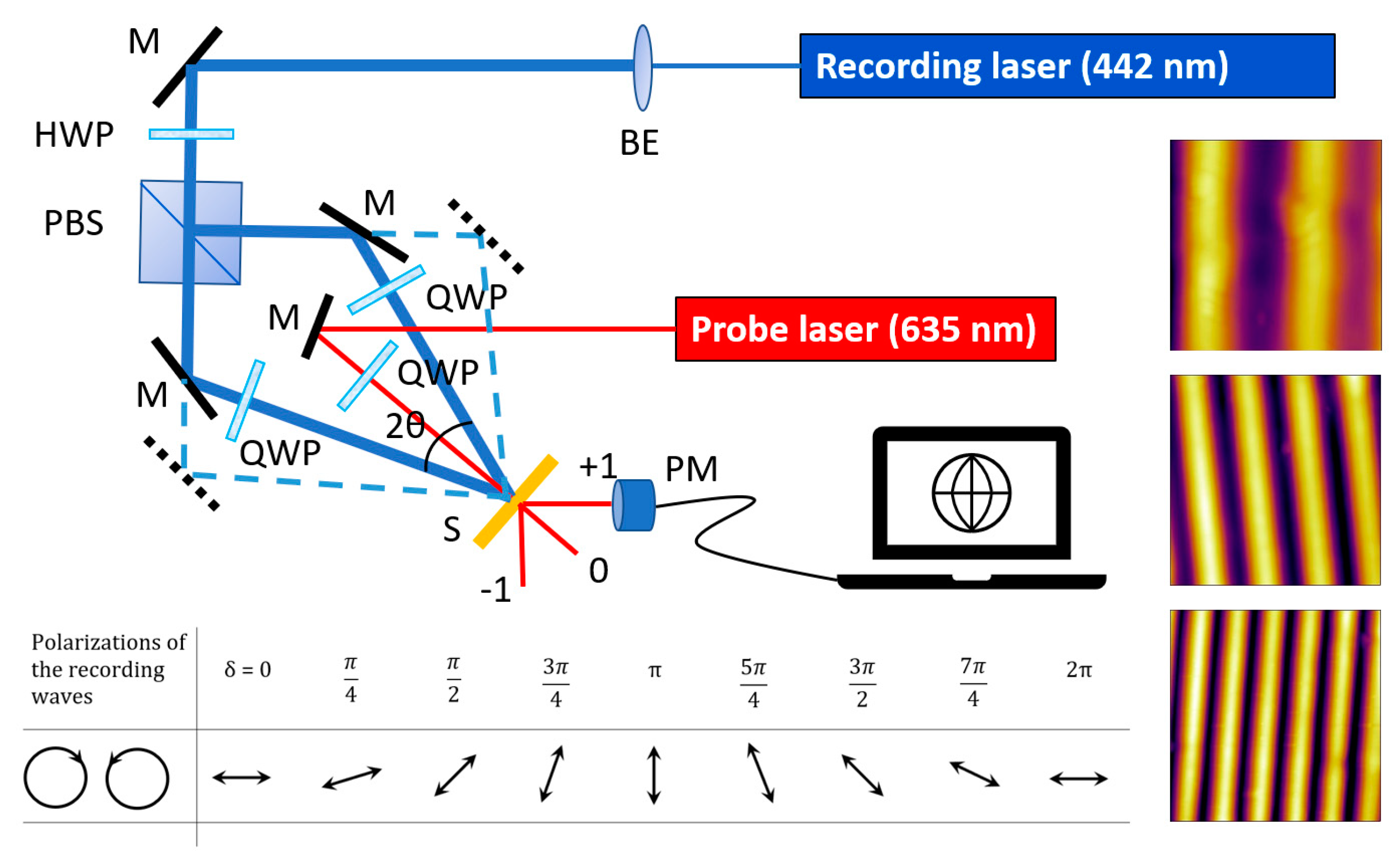
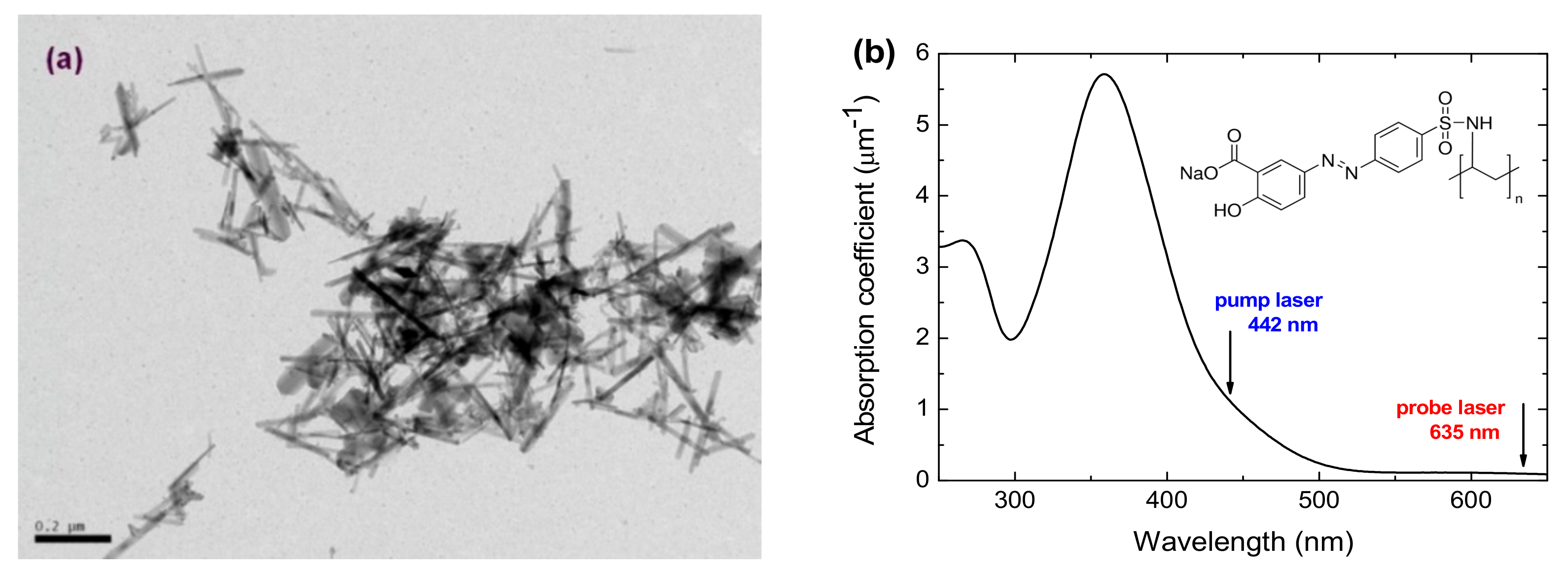
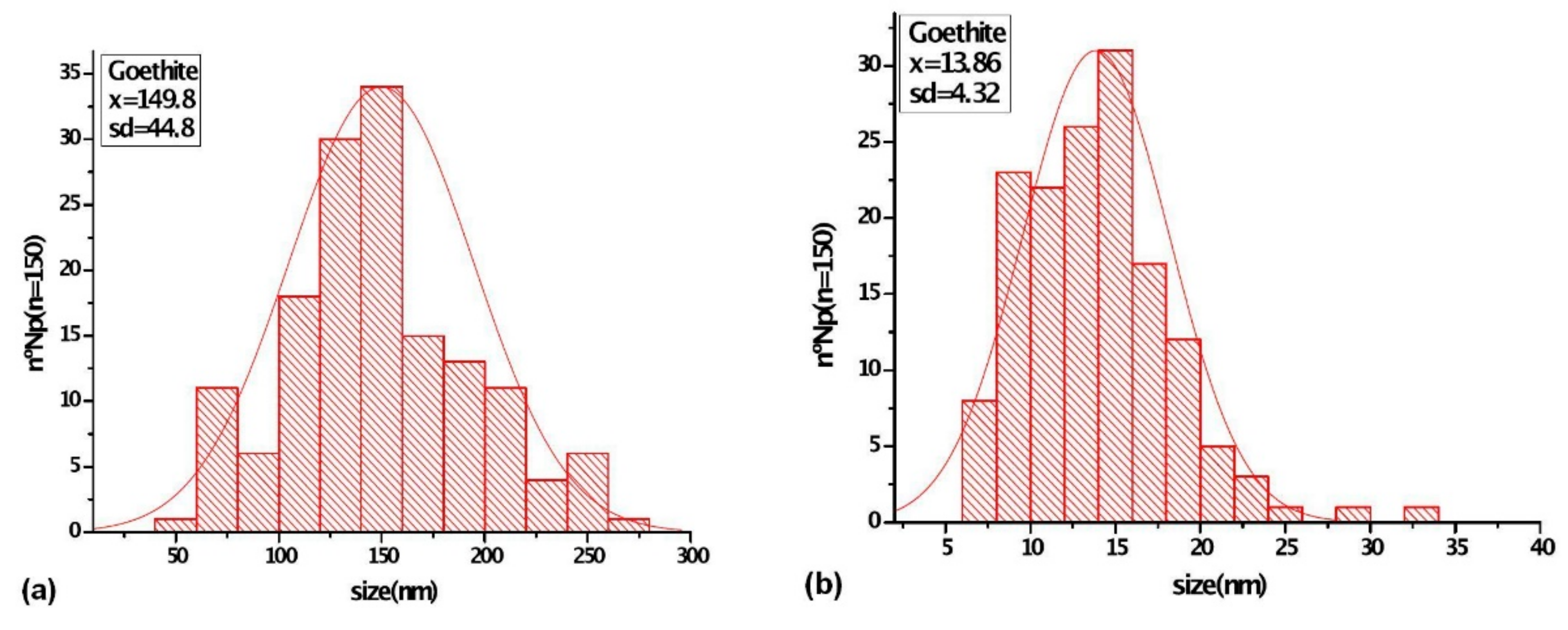
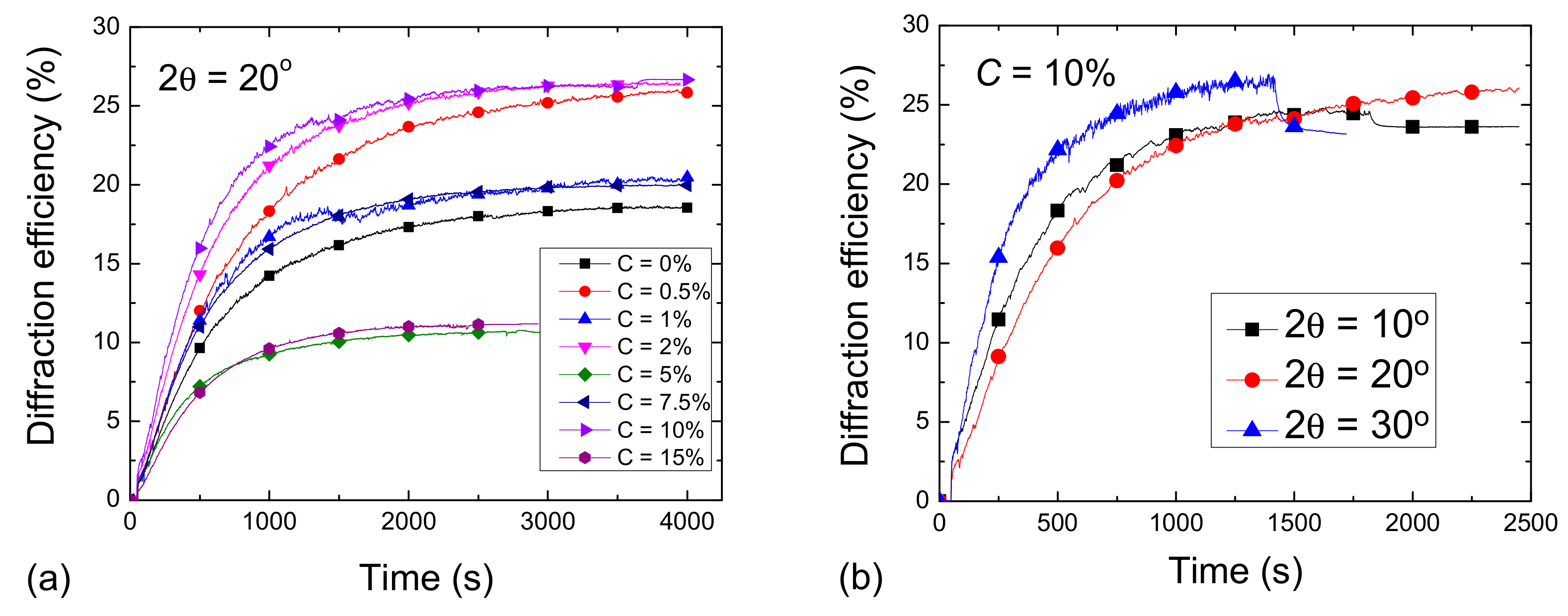
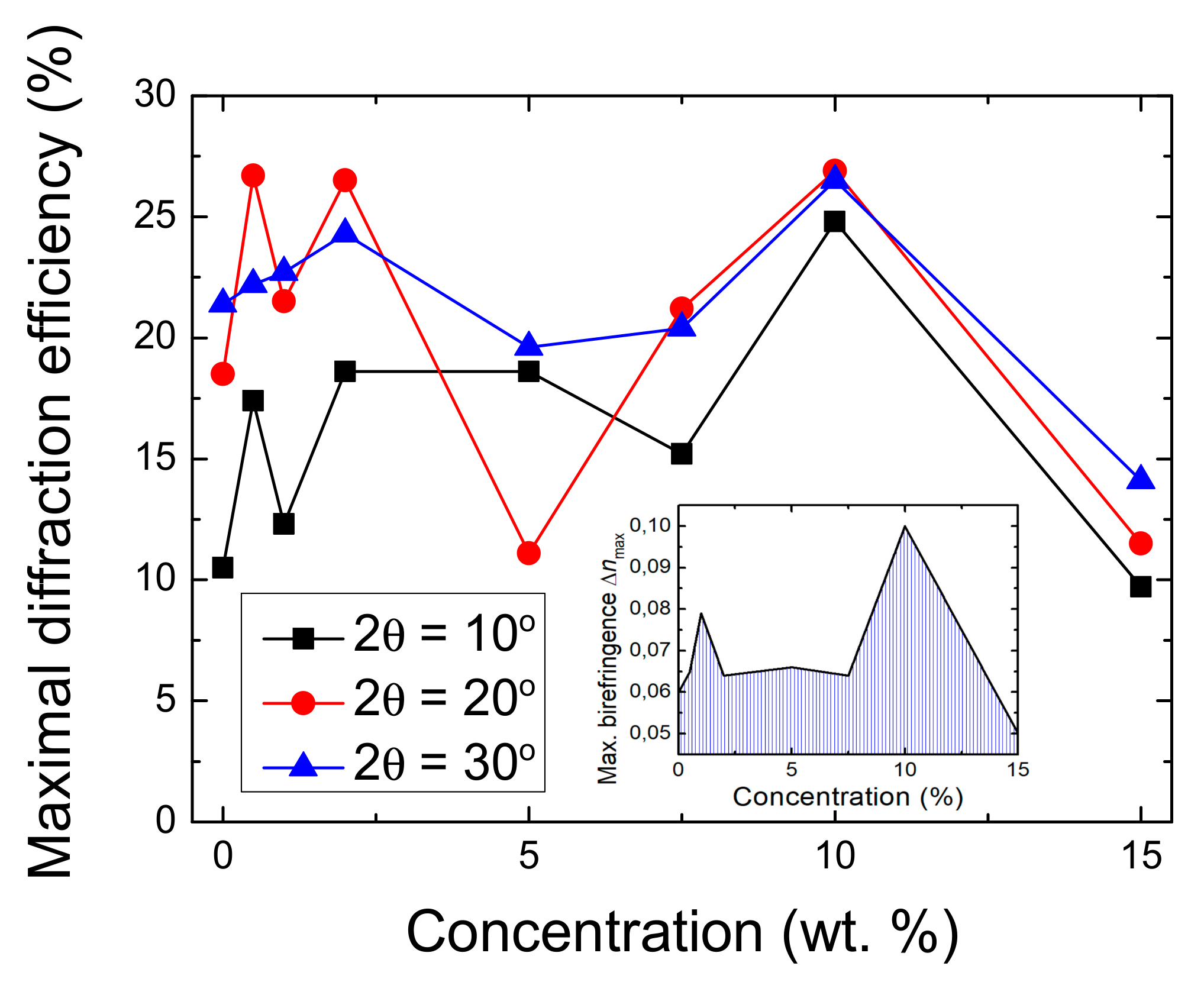
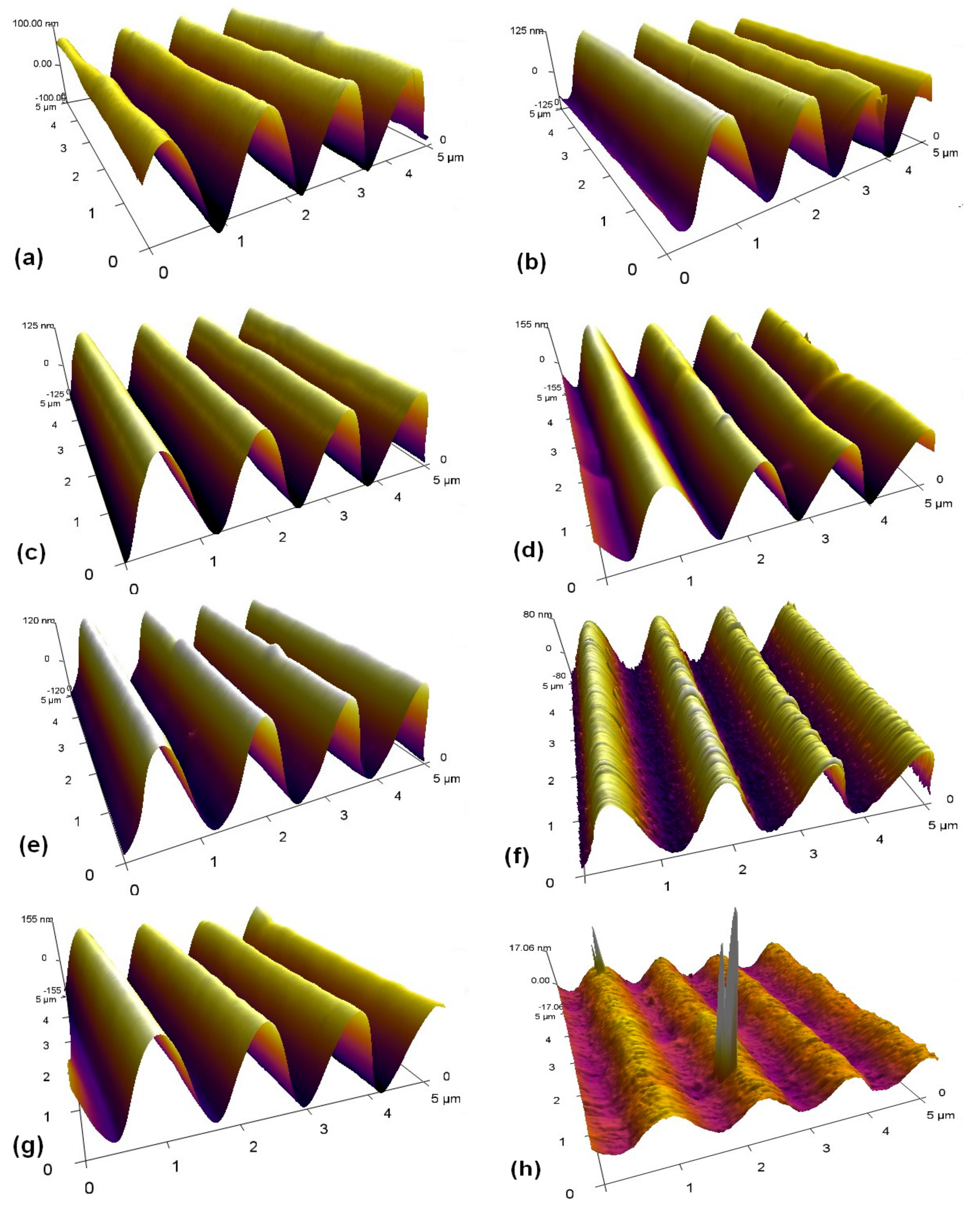


| C (%) | d (nm) | DE+1 max (%) | DE+1 (%) | DE–1 (%) | DE0 (%) | TDE (%) | TPR (%) | DEnorm (%) | hSRG (nm) |
|---|---|---|---|---|---|---|---|---|---|
| 0 | 450 | 18.5 | 18.2 | 17.1 | 47.2 | 35.3 | 82.5 | 42.8 | 170 |
| 0.5 | 460 | 26.7 | 26.5 | 24.8 | 30.1 | 51.3 | 81.4 | 63.0 | 220 |
| 1 | 430 | 21.5 | 21.0 | 19.7 | 42.3 | 40.7 | 83.0 | 49.0 | 245 |
| 2 | 470 | 26.5 | 26.3 | 24.5 | 30.7 | 50.8 | 81.5 | 62.3 | 270 |
| 5 | 420 | 11.1 | 10.8 | 9.8 | 58.1 | 20.6 | 78.7 | 26.2 | 235 |
| 7.5 | 410 | 21.2 | 20.8 | 19.7 | 36.3 | 40.5 | 76.8 | 52.7 | 160 |
| 10 | 400 | 26.9 | 26.6 | 26.4 | 15.6 | 53.0 | 68.6 | 77.3 | 280 |
| 15 | 450 | 11.5 | 11.2 | 10.3 | 48.3 | 21.5 | 69.8 | 30.8 | 15 |
Publisher’s Note: MDPI stays neutral with regard to jurisdictional claims in published maps and institutional affiliations. |
© 2021 by the authors. Licensee MDPI, Basel, Switzerland. This article is an open access article distributed under the terms and conditions of the Creative Commons Attribution (CC BY) license (https://creativecommons.org/licenses/by/4.0/).
Share and Cite
Nedelchev, L.; Mateev, G.; Strijkova, V.; Salgueiriño, V.; Schmool, D.S.; Berberova-Buhova, N.; Stoykova, E.; Nazarova, D. Tunable Polarization and Surface Relief Holographic Gratings in Azopolymer Nanocomposites with Incorporated Goethite (α-FeOOH) Nanorods. Photonics 2021, 8, 306. https://doi.org/10.3390/photonics8080306
Nedelchev L, Mateev G, Strijkova V, Salgueiriño V, Schmool DS, Berberova-Buhova N, Stoykova E, Nazarova D. Tunable Polarization and Surface Relief Holographic Gratings in Azopolymer Nanocomposites with Incorporated Goethite (α-FeOOH) Nanorods. Photonics. 2021; 8(8):306. https://doi.org/10.3390/photonics8080306
Chicago/Turabian StyleNedelchev, Lian, Georgi Mateev, Velichka Strijkova, Verónica Salgueiriño, David S. Schmool, Nataliya Berberova-Buhova, Elena Stoykova, and Dimana Nazarova. 2021. "Tunable Polarization and Surface Relief Holographic Gratings in Azopolymer Nanocomposites with Incorporated Goethite (α-FeOOH) Nanorods" Photonics 8, no. 8: 306. https://doi.org/10.3390/photonics8080306
APA StyleNedelchev, L., Mateev, G., Strijkova, V., Salgueiriño, V., Schmool, D. S., Berberova-Buhova, N., Stoykova, E., & Nazarova, D. (2021). Tunable Polarization and Surface Relief Holographic Gratings in Azopolymer Nanocomposites with Incorporated Goethite (α-FeOOH) Nanorods. Photonics, 8(8), 306. https://doi.org/10.3390/photonics8080306






